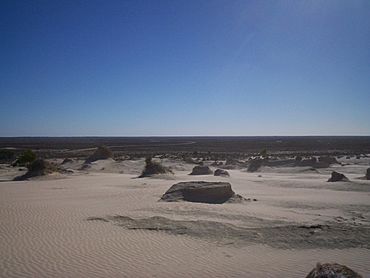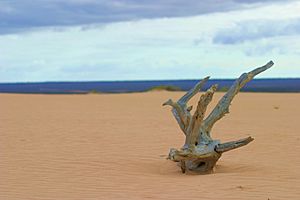Mungo National Park facts for kids
Quick facts for kids Mungo National ParkNew South Wales |
|
|---|---|
|
IUCN Category II (National Park)
|
|

Mungo Lunette, looking south towards Mildura, 2007.
|
|
| Nearest town or city | Pooncarie |
| Established | 6 April 1979 |
| Area | 1,109.67 km2 (428.4 sq mi) |
| Managing authorities | NSW National Parks & Wildlife Service |
| Website | Mungo National Park |
| See also | Protected areas of New South Wales |
Mungo National Park is a special protected area in south-western New South Wales, Australia. This huge park covers about 110,967 hectares. That's like 274,000 football fields! It's about 875 kilometers west of Sydney.
For thousands of years, Mungo National Park has been a traditional meeting place for the Muthi Muthi, Nyiampaar, and Barkinji Aboriginal Nations. To protect this special place, climbing the sand dunes is no longer allowed.
The national park is part of the UNESCO World Heritage–listed Willandra Lakes Region. This area covers 2,400 square kilometers and has seventeen dry lakes. Not all of these lakes are called Mungo, but they are all part of the World Heritage site. A creek that once flowed into Lake Mungo is now preserved as a sacred site.
Mungo National Park is about 75 kilometers south-east of Pooncarie. It is also about 110 kilometers north-east of Mildura, Victoria. The park is approximately 145 kilometers south-west of Ivanhoe. The roads to and within the park are unsealed. They can be tricky for regular cars, but SUVs or 4x4s can usually handle them with care.
Contents
Discovering Mungo National Park
The main part of Mungo National Park is Lake Mungo. This is the second largest of the ancient dry lakes in the area. Mungo National Park is famous for the amazing archaeological discoveries made there.
Ancient Discoveries
The remains of Mungo Man were found in the park. These are the oldest human remains ever discovered in Australia. Also found was Mungo Lady. She is the oldest known human to have been ritually cremated. Both were buried on the shore of Lake Mungo. They were found beneath the 'Walls of China'. This is a series of sand dunes on the south-eastern edge of the lake.
Visiting the Park
There is a visitor center near the old Mungo woolshed. You can get more information and a map there. A 70-kilometer circular driving track lets visitors explore the park. You can drive to the amazing Walls of China and around the dry lakes.
If you want to stay overnight, the Shearers' Quarters offers bunk beds. It also has a shared kitchen. You can pay daily fees for accommodation and park access at the visitor center.
Protecting Mungo National Park
Mungo National Park became part of the National Reserve System in 1979. This happened thanks to the Foundation for National Parks and Wildlife. This group raised money to buy the land.
The Foundation also helped fund an archaeologist. This expert worked at the site from 1979 to 1983. With money from Dick Smith, the Foundation built the Mungo Visitors Centre and Laboratory in 1983. Later, with help from BHP, they created the 60-kilometer guided vehicle drive in 1990.
In 2010, the Foundation planned to build a new center at Mungo. This center would be for education and research. Famous Australian architect Glenn Murcutt and Wendy Lewin were set to design the building.
See also
 In Spanish: Parque nacional Mungo para niños
In Spanish: Parque nacional Mungo para niños




